Case Studies
Industries
Resources
Ratings & Reviews
NEW
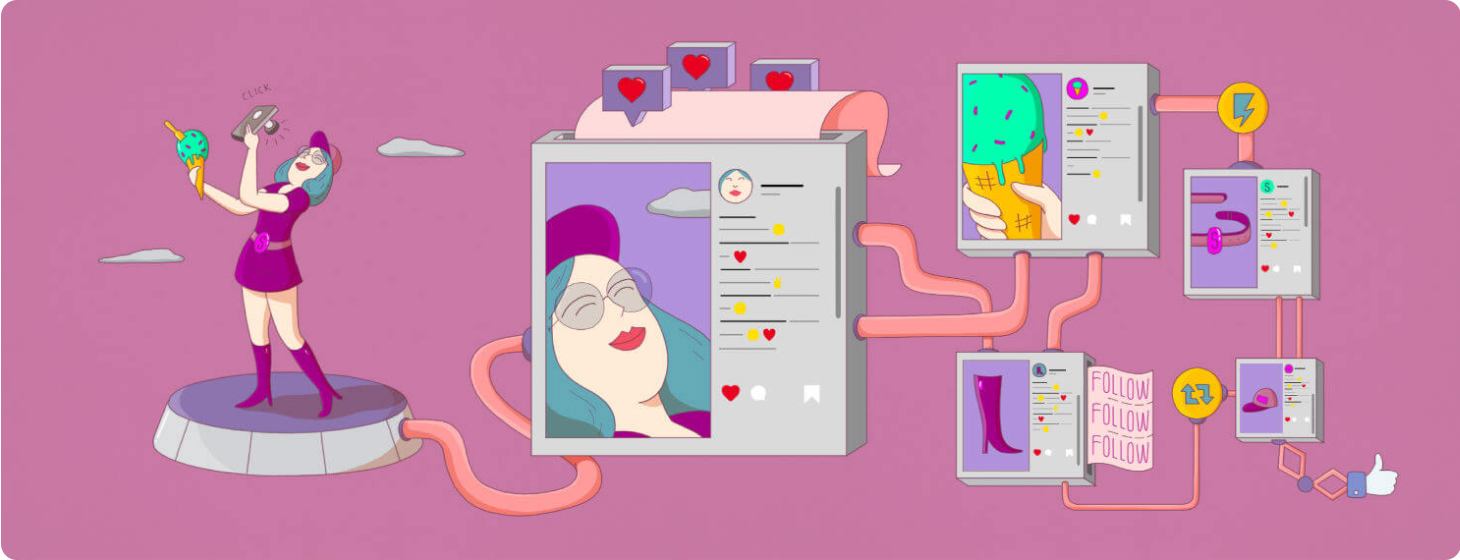
User Generated Content. Customer Content. Earned Content. Whatever you want to call it, you might’ve heard about UGC and the amazing things it can do for a brand. Maybe you understand the basic definition – it is right there in the title – content generated by users.
But still, when it comes to marketing we can’t help but ask … What is UGC? And how can brands use it to create connections with their target audience and ultimately increase conversions?
Time to jump right in and learn more about the powerful things UGC can do for your brand. Here, we’ll give you everything you need to know about User Generated Content management. Feel free to read all the way through or click directly to the paths that interest you the most.
For even more detail, you can click through to the related content included in each section. Let’s get started!
Discover more about why you should integrate social media into websites or how to embed an Instagram feed into your site.

So we get that UGC is content generated by users. But what does that really mean for a brand that is hoping to leverage customer content to increase brand recognition and sales? That’s the question we hope to answer throughout this article.
Let’s start with a concrete definition. In a nutshell, User Generated Content (UGC) refers to any content which has been created by a brand’s fans and wider audience that can be used to sell more of a product. This might take the form of pictures & videos shared on social channels, testimonials, reviews, tweets, blog posts, and more.
Obviously, it’s always super cool, as a brand, to hear that customers are happy with your products. But the beauty of UGC lies in the fact that it’s also super cool for other shoppers to hear how happy people are with your products. So, this customer content amplifies the nice things that consumers are saying about you to create brand awareness, instead of a brand promoting itself.
Plus, 78% of millennial are more interested in seeing UGC over Professional Content (PC). Plain and simple, people are more likely to engage with User Generated Content over any other type of content.
When you think about it, the benefits of UGC are endless. Deep down, we all know that people respond better to brand messaging when it isn’t the brand making the messaging themselves.
But, if this isn’t enough to convince you, I can give your brand an even better reason to try UGC: it helps eCommerce stores increase conversions by 15% on average.
That’s right. This isn’t just a cool idea to help heighten your brand’s connection to your target audience (though it can help you immensely in that department!). The data actually supports customer content’s ability to boost sales.
Further, we conducted a study which showed that UGC photos are 5X more likely to convert compared to PC.
UGC photos are 5X more likely to convert compared to professional content
With so many benefits, UGC is truly a must for eCommerce stores. So you really know what I’m talking about, let’s talk about all of the benefits of UGC, starting with the OG brand goal: getting your customers to trust you.
Looking for more? Check out 2 great resources for more information on the benefits of UGC:
User Generated Content: Why integrate it?
What can User Generated Content help you achieve? It can help you…
Now that you have a general idea of what UGC is, let’s take a look at everywhere that it can be found.
So why is User Generated Content important? User Generated Content (UGC) has emerged as a pivotal force in modern business strategies, with far-reaching benefits that cannot be ignored. At its core, UGC cultivates trust among customers by offering authentic, real-world experiences and testimonials. This innate trust-building quality establishes a solid foundation for brand loyalty and a sense of community, as customers feel more connected to a brand that values their voices. The significance of UGC extends beyond trust-building, resonating in its remarkable efficiency. By harnessing the creativity of existing customers, UGC becomes a cost-effective avenue that saves time and resources while delivering a substantial return on investment.
This genuine, customer-driven content, exerts a profound influence on purchasing decisions, driving conversions through relatable, practical examples. UGC is connected with the realm of social commerce, enriching the shopping experience and bolstering engagement. Through UGC, brands unlock a powerful mechanism that not only reinforces authenticity but also shapes purchasing behaviors, fostering a synergy between customers and commerce.
Traditional marketing strategies involve content that is created by the brand themselves (or an outsourced advertising agency), whereas UGC features content that is created by social media users, User Generated Content Creators or influencers and is then gathered by the brand.
UGC marketing is substantially cheaper than traditional content, as well as requiring fewer resources to produce. Sometimes UGC is not completely free to produce, when working with influencers or when relying on a UGC platform, for example, however, even in those cases it tends to be far more cost effective than traditional forms of marketing.
UGC is highly adaptable too, a user-made video product tutorial, for example, can be repurposed as a video ad, in digital signage, or cut into a video compilation.
The sheer volume of organic UGC means that it can be displayed in shoppable feeds or endless carousels, making sure that consumers never get bored because there is a constant trickle of content to be consumed.
Traditional marketing can have the benefit of high production values, with polished video editing, writing, styling, lighting, audio and image quality etc., so in that sense, traditional marketing can lend a more aspirational or professional brand image. That being said, sometimes the authenticity and real-life quality of UGC is precisely what consumers connect with on a deeper level – it depends on the goals of the marketing strategy in question.
Many marketers however are relying on UGC more than ever before and given higher ROI and the ease of AI-driven automated UGC tools it’s not hard to see why.
Everything has it’s pros and cons including UGC, and pros outweigh the consSo what makes UGC so great?
Since this content has been ‘crowdsourced’ from everyday folk, it has a notably raw and authentic feel. Plus, the product is being used by someone who isn’t a model being shot in a studio. They’re real people, in the world, taking nice pictures with your products. Why wouldn’t you want to use them?
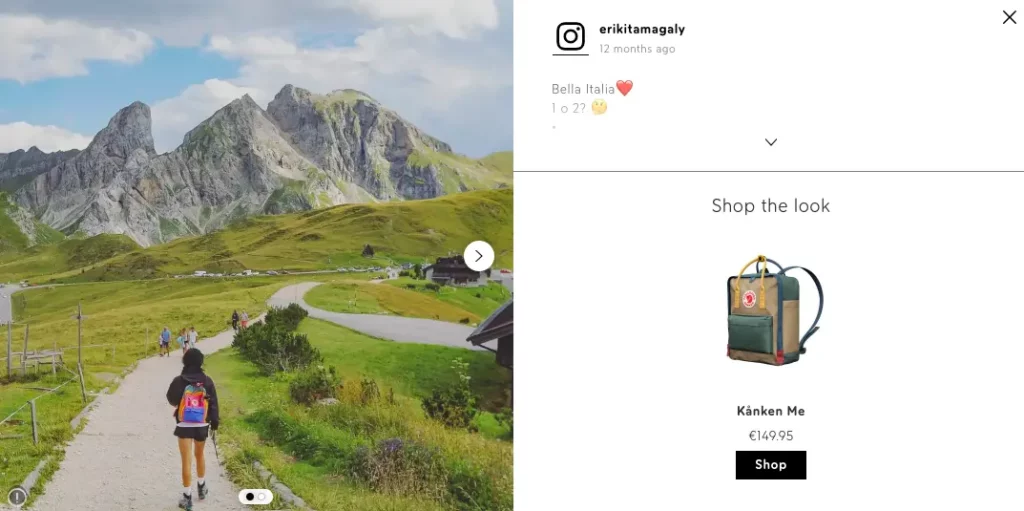
Since brands that run User Generated Content campaigns are seen as authentic, it naturally follows that consumers trust them more. In fact, studies show that a majority of consumers trust customer content 50% more than other media.
And if 70% of customers check product reviews before purchase, UGC will help you reinforce the reliability and performance of your products.
While three-quarters of shoppers are influenced by social content, every brand out there is vying to be an influencer. So building trust with your target audience should be high on every brand’s list.
Shoppers have too many options to waste time on a brand that they don’t believe will deliver a consistent product. Make sure your customers know that when they buy something from you, they’re guaranteed a product that everyone trusts and loves.
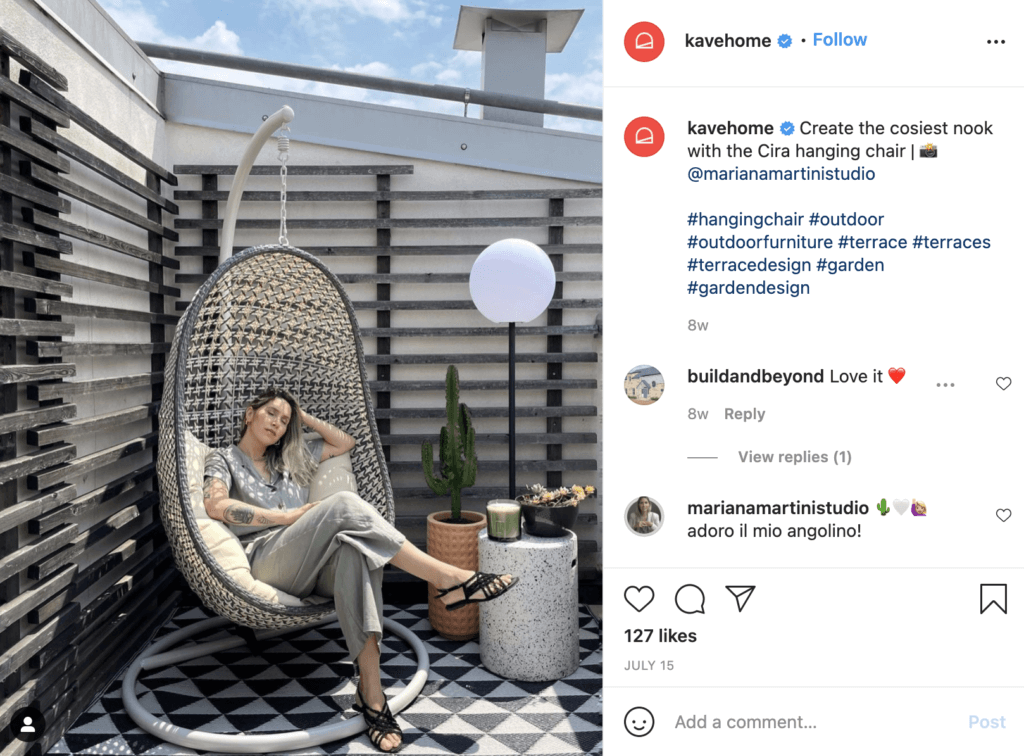
People are already talking about you on social media. They’re already comparing products and listening to peer recommendations of what to buy. So why not harness all of this social proof, and use it to impress your shoppers?
Let’s not kid ourselves: sometimes we don’t have the time, energy or resources to come up with killer content day-in and day-out. (Especially if you’re a small team, and the same person who manages your social media channels also doubles up as a photographer, marketer, and blog article writer!)
However, when your content person plays the role of ‘curator’ versus ‘creator’, their job become much easier.
If you’re able to encourage and curate customer content on a regular basis, you instantly lift the burden of constant content creation. Each time a follower tags you and leaves some sort of positive feedback or asks a question, you are presented with an opportunity to use customer content to your advantage.
For the content creators behind your brand, the benefits of encouraging and curating customer content are three-fold:
If nothing else, incorporating customer content into your feed is a fantastic supplement to your existing social strategy. Since User Generated posts are truly organic, they’re a welcome break from pieces that you’d normally create and boost yourself.
And not only that, but users are already creating this content. 95 million photos are uploaded daily to Instagram. And don’t forget the 30 billion pieces of content published to Facebook monthly. It’s already being generated, just learn how to curate it.
Looking for more? Check out these resources for more data on why UGC is a benefit to your brand:
UGC Stats: 6 Statistics Every Marketer Should Know About User Generated Content
The current marketing landscape is always scrambling to keep up with the wants and needs of the consumer being targeted. With the fast-paced digital world always in motion, information moves fast and consumer desire changes just as rapidly. Consumers are now accustomed to fielding marketing content from companies that are able to keep up with their quickly evolving wants and needs. UGC positions the consumer at the center of the marketing process and is one of the most customer-centric forms of marketing available.
Customers are endeared towards brands that they feel share their same values. User Generated Content is an authentic way to share products and services in a way that consumers can emotionally connect with.
Not only is UGC authentic but it also fosters a sense of community and creates a shared narrative around a particular product or brand. Rather than a corporate entity marketing products and services in a glossy and detached manner, User Generated Content gets the consumer involved, encouraging them to share their use of products with other social media users. This mechanism builds more of a sense of community than more traditional marketing formats. UGC could be described as content for consumers by consumers.
UGC is often free to collect, with users creating the content themselves (however in some cases brands work with influencers that are paid to post specific content to be used in UGC campaigns.). As far as marketing formats go – UGC is by far one of the most cost-effective.
Not only is User Generated Content cost-effective, but it’s also has an impressive return on investment (ROI) because it can be created in large volumes without costing you anything. UGC can lead to increased profits and coupled with the lower overhead marketing cost it creates the ideal conditions for a larger ROI.
User Generated Content doesn’t just mean content on social media platforms like Instagram and Facebook. From the tutorials and how-to’s of User Generated Content on YouTube to consumer star ratings or reviews of products, there are tons of different ways for your customers to share with the world just how happy they are with your brand’s products. But are you taking advantage of them all? Here are the different types of UGC:
Visual content like images and videos collected from social media are the content formats that are more commonly associated with UGC. That being said there is more user content out there beyond content found in social media posts. Take a look at the section below to learn everything you need to know about the less commonly discussed forms of UGC and how they can help your brand’s eCommerce efforts.
This is the good old fashioned User Generated Content that you can collect and integrate directly into your website to use as social proof. Seeing as 95 million photos and videos are posted on Instagram alone per day, social media is a non-stop shop for UGC.
Once you get your users to start posting on your hashtag – a process you can learn all about here – you now have a one-way ticket to all of those authentic customer photos and videos featuring your products.
Now, you can collect that content and use it on your eCommerce site. The process looks a little something like this:
At this stage, you’ve made it to the golden hour of UGC. There are a lot of attractive ways to integrate earned content directly into your eCommerce storefront or product pages to increase sales. Take a look at how watch brand Frederique Constant uses their User Generated Content galleries to gain customer trust.
From here, users can click on a piece of customer content and shop directly from the visual recommendation of one of your devoted clients. Visual commerce magic!
If you are looking for more information on collecting, integrating and leveraging customer photos and videos into your shopping journey, read our extensive guide on creating a User Generated Content strategy. We’ve got all of the information you need to execute a winning visual UGC strategy here.
88% of online shoppers incorporate reviews into their purchase decision. Why are they such a credible source for buying information? Because it’s coming directly from actual people looking for the same solution (aka UGC).
88% of online shoppers incorporate reviews into their purchase decision
Customer reviews were the original UGC, back when brands sold only in stores. Now that we’ve migrated online, so have good, old customer reviews meaning tons of ways to incorporate them into your online store to prove to future customers that your products are reliable.
There are third-party review sites like Yelp, Trustpilot, or TripAdvisor that form online review directories where consumers go to find customer experiences with a particular product or service. However, integrated solutions that allow eCommerce providers to host customer reviews and/or star ratings on their own websites directly are growing in popularity.
Just like we specialize in the collection and curation of visual forms User Generated Content we also specialize in offering top ratings and reviews solutions that allow brands to manage review and star rating requests and collection, as well as moderation, analysis, and distribution.
Looking for more?
Twitter often gets left behind when we start talking User Generated Photos, but it can be a great resource for customer interaction that brands should capitalize on.
Content creators can learn a thing or two from companies such as Denny’s, who consistently flaunt their sense of humor. They’re basically known for their hilarious Twitter account that often responds directly to user comments, all the while keeping up their playful tone.

Now other Twitter users can have a little chuckle, as well as be reminded that Denny’s is open 24/7.
Don’t forget: Twitter can also be a great resource for collecting customer photos.
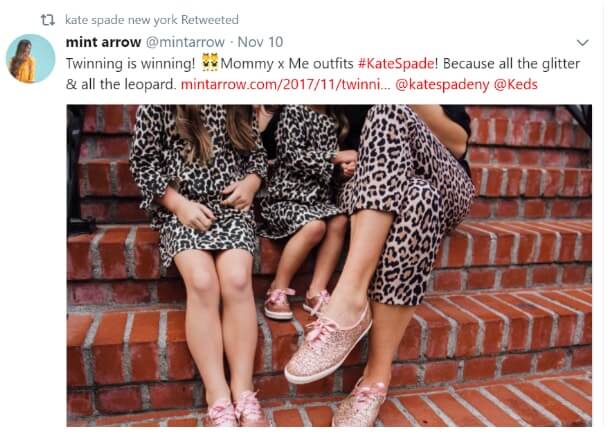
By retweeting their mention, Kate Spade is organically spreading UGC as social proof. To further this UGC magic, they could take this photo and integrate it directly into a product page or gallery on their homepage. And the UGC benefits just keep coming!
Considering that User Generated photos are being shared by the millions on social media platforms, there’s certainly plenty of content out there for brands to leverage.
7 out of 10 YouTube subscribers relate better to their favorite YouTube content creator than to traditional television or movie stars. 40% of millennials believe that their favorite YouTuber understands them better than their friends. Those numbers almost seem unbelievable, until you take some time to break it down.
Why is it that YouTubers earn a reputation of being more relatable and understanding? Because they are just users of the platform sharing their opinions with other users.
Content created by users on YouTube, even if it is in a marketing nature, has an authentic feel that helps to gain the viewer’s trust. Plus, earned fan videos are viewed 10 X more often than owned videos. User Generated Content videos are incredibly effective in terms of engaging audiences, not just videos from YouTube but from User Generated Content from TikTok or Instagram Reels as well.
Here’s an example of how useful YouTube UGC can be: an unboxing from UrAvgConsumer. Now, shoppers have an opportunity to see what exactly comes with new products, how to use them, and how well they work – and, more importantly, it wasn’t the brand that told customers how great it is!
You know on Amazon how you can add products to your wish list to come back to in the future?
This is also User Generated Content!
Amazon uses that information to create a Master list called ‘Amazon Most Wished For’. Here, Amazon users (these days there are 100 million Amazon Prime Members globally) can browse the products that other people are interested in. And, because Amazon is on point with it’s UGC, you can also see those trusted star ratings directly under the products.
Then, brand recommendations of this nature can even be used in tandem with other forms of User Generated Content. For example, back to YouTube videos.
Check out how FionaFrills shops products from the Amazon Most Wished For list and unboxes them in a video.
Getting your product on a video like this – which has 1.2 million views by the way – will get your brand not only amazing exposure but also earn you a trustable reputation.
The same can be done with playlists on Spotify or book lists at Barnes and Noble. The more you get people sharing, the more other people will want to engage along too!
When it comes to customer content, the sky’s the limit. Time for some real-life inspiration – check out how these other brands are leveraging their UGC Marketing via stunning UGC Flows, and have a think about how you can incorporate earned content into your own strategies.
What Unisa Europa is able to do with their UGC is create community of brand lovers. Through #MYUNISAS, shoppers can scroll through pictures to see how existing customers have paired the shoes with a certain outfit.

Here’s the smart part: upon clicking on a picture, there’s a specific link to the featured product, making it extremely easy for the viewer to shop the look!

It’s widely known that the best advertising doesn’t simply sell a product. Instead, it sells a lifestyle. One easy way of having your potential customers associate a certain lifestyle with your eCommerce store? Use a customer content gallery which showcases the kind of image you’d like to portray, like international clothing brand United Colors of Benetton.

United Colors of Benetton is clearly going for a bright, stylish, and trendy style with the pictures featured on its customer content gallery. When scrolling through this gallery, it’s easy for shoppers to get what the brand is about.

By showing off their products on real customers, it gives potential customers a sense of satisfaction. They’ll be able to visualize what shape or style might look like on them, which helps customers determine whether or not they want to purchase the product. Furthermore Meller uses the Trustpilot integration on the Flowbox platform which increases conversions through encouraging brand trust.
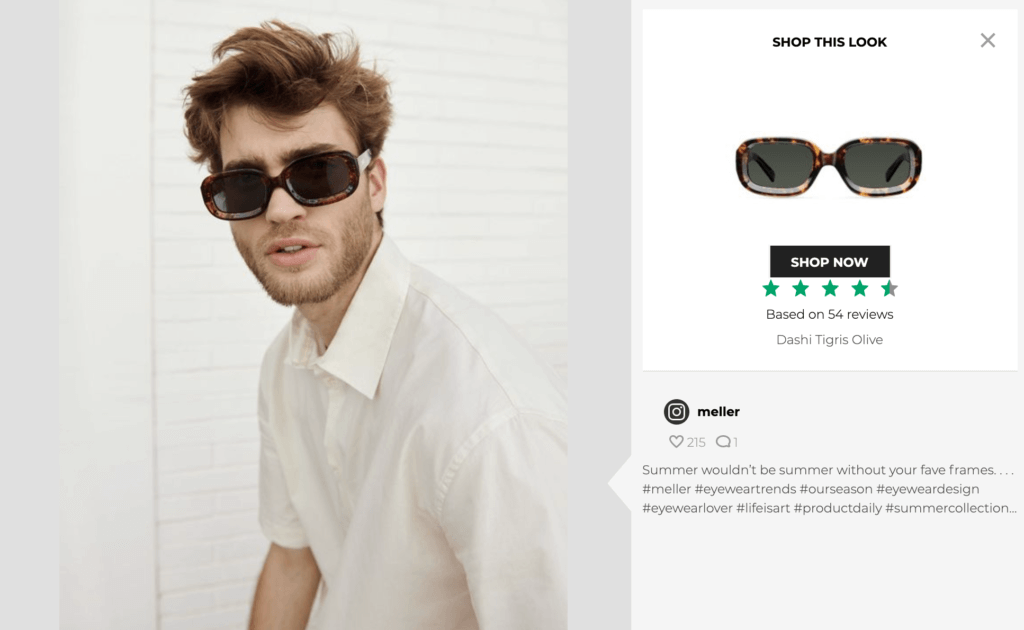
Now the customer knows that the product not only stylish but excellent quality.
Want to find out more? Have a look at the case studies of brands already leveraging UGC
UNISA: Rewarding an online community with recognition
MELLER: Building an online community around the brand
Looking for more? Check out these killer resources User Generated Content examples.
UX guidelines for adding User Generated Content to your eCommerce Website
UGC is sounding pretty good, right?
Before I further explain how User Generated Content will help your brand, let’s talk about Social Media Marketing.
I don’t think I need to spend a lot of time convincing you that social media networks are a crucial eCommerce tool. This is especially true considering the staggering 95% of millennials that follow brands on social media and the 73% of Gen Z who said they plan to use social media more. Furthermore about nine out of 10 people said they would buy from companies they follow on social networks.
These users aren’t afraid to shop on their phones either, with those who said they increased their spending with a brand they follow rising since 2019 by 12% to 75%. So when 66.6% of the world owns a mobile phone, it’s seems like perfect time to utilise social media to increase sales.
9 out of 10 people said they would buy from companies they follow on social networks
But if you’re still evaluating how well you’re performing on social media platforms by simply looking at your follower count, you may be missing the point.
Here’s what you need to know: modern social media marketing has a lot less to do with vanity metrics such as ‘Likes’ and follower counts than you may think. What’s the point of having thousands of followers if they result in no meaningful leads, conversions or sales?
Focus instead on using Instagram as a way to build an engaged brand community to promote brand awareness. The first step: posting content that resonates with your target audience.
Ahh yes. The eternal struggle: generating content that will constantly interest and excite users. Well, the formula for strong content doesn’t have to be rocket science. It can be as simple as re-posting User Generated Content that you know will spark their interest.
With the added bonus that UGC instantly encourages others to join your community, too.

Think about it: if sportswear and sporting goods brand, Decathlon, posted a product shot of their skis, snowboards, skiwear or skiing equipment on the shelves (or even a picture of a model holding them), it definitely wouldn’t have elicited as much engagement as this of the products in action did picture did. This picture speaks a thousand words, it speaks to potential customers who are interested in going on an action-packed adventure, like many of to the pre-existing customers, but don’t know where to go. The beauty of UGC is that epic pictures like this one show customers what your brand is about and what it can do for them. In addition, showing the product in use and being pushed to the limit, shows Faction’s target audience that their product is both desirable and reliable.
And it doesn’t just have to live on social channels – your social media marketing strategy can include UGC on your website, ads, you name it (more on this to come!) Plus, Shopify notes that User Generated advertising receives four times higher of a click-through rate versus any other type of marketing.
User Generated advertising receives a 4 times higher click-through rate
An effective social media strategy is rooted in three elements: responding to the wants and needs of followers in real-time, presenting your brand as a personality (versus appearing robotic or corporate), and boosting content that strikes a chord with your audience.
User Generated Content helps you achieve all of these elements on social media platforms and here’s how.
According to a study by Sprout Social, approximately 57% of social users cited “too many promotions” as the number one reason they unfollow brands. Meanwhile, ad-block usage is at an all-time high worldwide.
57% of social users cited “too many promotions” as the number one reason they unfollow brands
Yup, it’s pretty obvious these days: constant self-promotion is a predictable way to drop your follower count and tune out your target audience. Brands need to be tactful in terms of how they present their products, or customers are quickly going to move on.
That’s where customer content comes in. Customer content represents a win-win for brands and followers alike – not only does it remove the sales pitch from your promotional posts, it also shows off your products in action.

Now, your followers don’t just want a product. They want an experience with your product!
Brands should strive to take each and every opportunity to sell beyond the realm of boring product pages. Instead, place products in a real-world setting which is both eye-popping and helps your followers visualize a personal connection with your brand.
Why not check out how TopVintage leveraged UGC to showcase their products in this case study.
Speaking of personal connections, consumers today want to put their trust in people, not brands. This is especially true when it comes to the younger crowd.
The only issue is, brands are not people.
But you know who is? Your customers.
When you can encourage customers to take and post pictures with your products on social networks, they can become the many faces of your brand. A great way to get them interested in selling for you is by showing some personality.

Consider how small touches of humor, attitude, personality, and puns within your Instagram captions or tweets can remind your followers that behind every brand interaction is a real-life person, not a robot.
Of course, not every social media manager needs to (or even can) be a stand-up comedian. But you’re better off showing some human side to your brand voice and image – remembering again that the best human side could come from the humans that buy your product.
Whatever route you decide to go, when it comes to tone and customer content, make an effort to be genuine rather than trying to fake a marketing message that doesn’t jive well with your brand or your target audience.
Part of the beauty of social media networks is the fact that followers and brands are on a level playing-field. Both parties are just an @ away from each other.
The ability to interact with followers in real-time not only serves as means of customer service but also as a tool for curating User Generated Content.
When you become known as a brand that responds to your interactions on social media, users are going to give you more engagement.
For example, natural cosmetic brand, Lush, encourages customers to ask about the best products for their skin or hair type directly on Instagram posts.
And, to follow through on the personalization that their brand strives for (on each product that they sell it says exactly who packaged the product for you), they even sign-off their Instagram responses to let the customer know exactly who they’re hearing from:
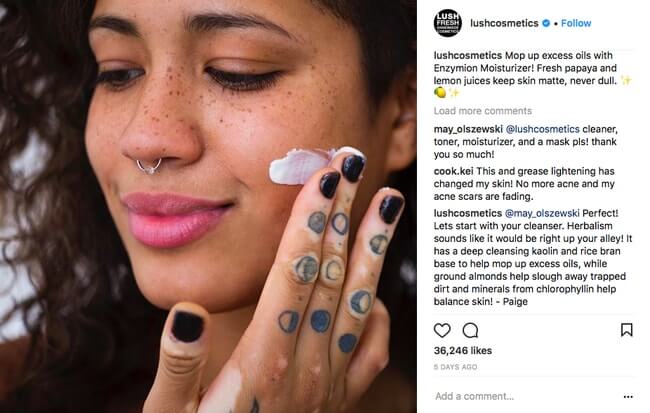
Remember: customers don’t just want responses from brands, they expect them. Although responding to your followers may not seem like a make or break situation from a marketing perspective, 5 in 6 messages in need of a response on behalf of followers are never answered.
As noted by Forbes, 62% of millennials want to get in touch with their favorite brands via social and 60% cite brand loyalty as a factor influencing purchasing decisions. That means they’re thinking about how receptive your brand is to their needs while they make their purchasing choices.
62% of millennials want to get in touch with their favourite brands via social
Taking the time to both seek out and respond to your audience is a small touch point that most brands aren’t willing to commit to.
Don’t be one of those brands. Use social media as it’s intended to be used – as a social platform – and users will respond positively.
Over 86% of businesses have some sort of User Generated Content strategy in place. Meanwhile, 84% of millennial consumers claim that user-generated content has influenced the way they do online shopping.
The “pump and dump” approach to content via social media is dead and buried. Likewise, if you aren’t giving your followers a voice, you’re inevitably holding back your ability to grow.
Looking for more? Check out this stellar resource to learn more about integrating UGC into your marketing strategy:
User Generated Content Marketing: Integrating Customer Photos Into Your eCommerce Store
This form of content is fairly adaptable, meaning that there are different ways to incorporate it into a brand’s marketing strategy depending on its needs. That being said, there are some general guidelines or User Generated Content best practices that are recommended when it comes to this type of strategy.
Brands should endeavor to pick the right social network for their brand. Usually pulling UGC from lots of different sources isn’t necessary, some brands just stick to Instagram, whereas others are more likely to capture the right content from their audience on Facebook. It is recommended that marketers begin with and prioritize the right channels as part of their strategy.
Another practice that is beneficial for marketers is to think about the appropriate channels on which to share the UGC they have gathered. Sometimes the best platform to share UGC is the same platform from which it was gathered. Most brands find that incorporating User Generated Content into their website is a winning move, but it can also be utilized in events, email campaigns, paid to advertise, and more.
One of the most important guidelines to follow is getting permission from the content creators to share their content. Not only is it best to ask for permission but it is also best practice to credit the creator somewhere, often when you hover over UGC on brands site you will be able to see the Instagram handle of the person who created the image or video.
While we can acknowledge that follower count isn’t everything, it never hurts to bump up your numbers. The more followers, the more UGC you’re likely to receive.
Thankfully, UGC breeds UGC. Once you start implementing it within your strategy, you’re sure to hit a goldmine of new followers for your feed, all without needlessly spammy posts.
Check out how wildly popular watch brand, Cluse, uses its #CLUSE hashtag to simultaneously promote their products and leverage a user-submitted photo to encourage new photos from their followers:
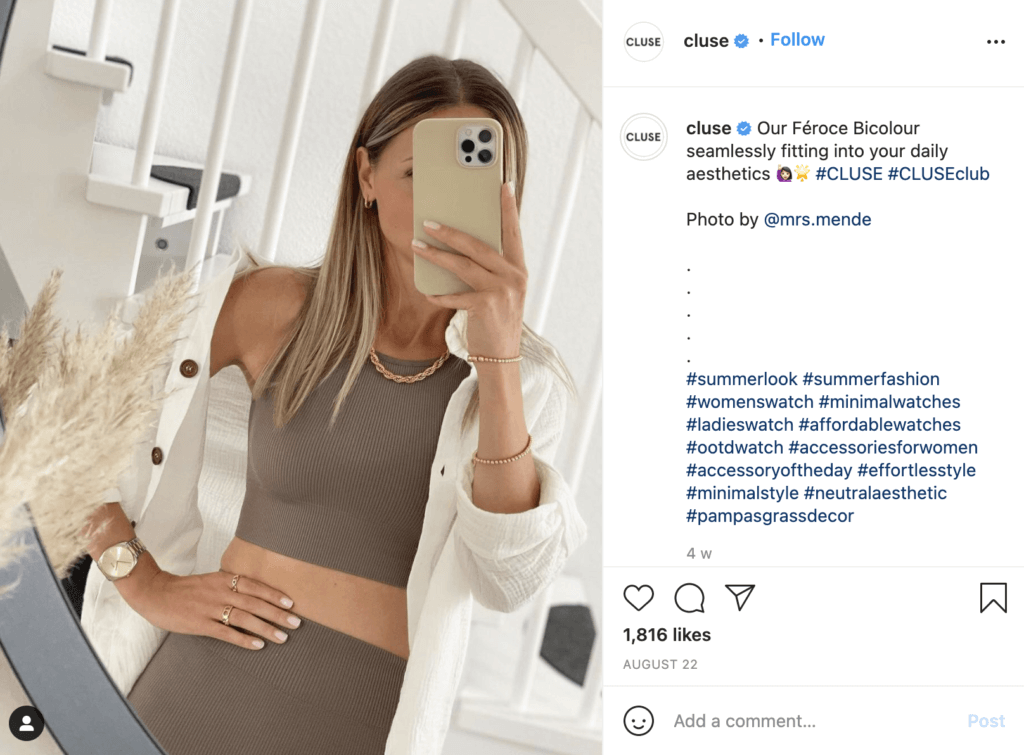
If we delve into the images posted via the hashtag, it’s clear that fans are responding in the form of customer content.

This encouragement is a win-win for CLUSE: their products spread through the social space at no cost and non-followers are exposed to their tag. Brands that know how to create hashtags that are effective also know how to encourage their content to spread like wildfire.
Find more about CLUSE’s use of UGC in this case study.
But getting the process started can seem daunting when you’re only beginning. However, it can be as simple as asking for a review or starting a customer content campaign.
Let’s break the process down starting with reviews.
Think back to a time when you left a review of a product or a company. What motivated you to take action? Chances are, it was one of two scenarios: Either you hated the product or service and left the review to keep others from making the same mistake of buying it or you liked the product or service, and they asked you to leave a review.
The first scenario doesn’t require any action on the seller’s part – you left it on your own will.
The second, however, most often requires them to reach out to you and ask. Otherwise, you may not have been inspired to leave the review despite your good experience with the product.
Here’s an example of how Amazon does this:

People tend to talk more about negative experiences than positive ones, so that’s why your customers often need a little nudge to get to sharing!
So, prompt your users to give a review. Send them an email, reach out to them on social media, or call them and ask.
Now you can use this same model when it comes to UGC.
The bottom line is this: Users are already taking and sharing photos. You just need to get them to take pictures while using your products and tag them with your hashtag.
How can you do that?
Here’s a 3-step process:
Step 1: Do an audit to find your current customer content.
If you haven’t been tracking it, there’s a good chance some of your customers have already posted images of your products without you even knowing it. To find them, search for your brand on Instagram using #yourbrand.
On top of that, also search for hashtags that mention your product or where your brand has been tagged; if you have a brick-and-mortar store, search for anyone tagging your store location. (You can even use our visual commerce platform to make this process easier!)
Understanding what kinds of photos people are already taking will help you with the next step, which is…
Step 2: Create a User Generated Content campaign.
Hosting a campaign and giving away products to random winners is the first step in getting loads of customer content. People love associating themselves with good brands (and getting free stuff).
When crafting your campaign, be sure to think about your goal – do you want to generate more reviews which you can use on your product pages or do you want to get your followers to contribute to a hashtag so that you can dominate Instagram?
If it’s the latter, make sure to create a unique hashtag for your brand – whether it’s the name of your brand or something new – make sure that when people post with this hashtag it’s intentionally for you. This makes it easier to collect your UGC in the future.
Once you start encouraging users to latch onto your addictive hashtag, you’ll start to see your UGC coming in.
Step 3: Engage with your customers.
Be sure to respond to their comments. Don’t be afraid to comment on their photos, repost them on your social media accounts, and randomly give them free gifts. They don’t have to be expensive, either! For example, you can send your customers fun, branded stickers which they can paste on their laptops or other gear.
The more you engage with them over time, and they see the rewards of posting a photo or writing a review, the more they will remember your brand in the future.
Looking for more? Check out our guide to growing your collection of User Generated Content. Full of actionable strategies of how to get customers to post UGC, you’ll be filling galleries on your website in no time: Consumer Generated Marketing Guide
So you’ve started gathering your brand’s consumer content and encouraging customers to create more – the circle of engagement, as we like to call it. It’s up on your site in a stylish gallery or carousel (which can be powered by Flowbox!)
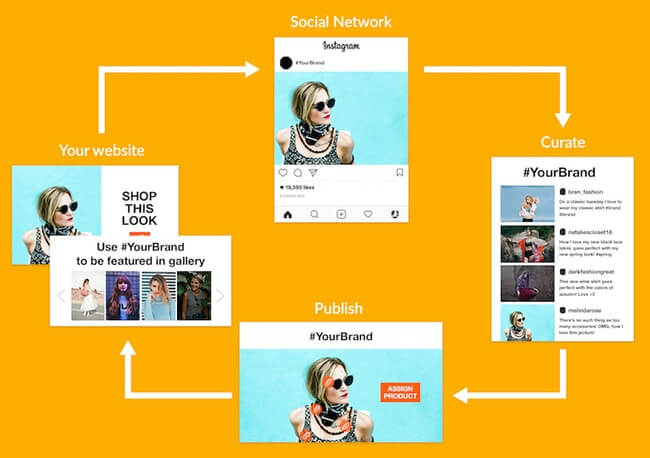
Now you get to witness the power of UGC, and maybe you’re wondering: can it go further?
Of course it can! You can and should employ the right User Generated Content management strategies stretch your earned content as far as it can go – and here’s how.
We’ve seen time and time again how conversion rates increase with UGC, building trust, and painting posts with a more personal touch.
Why not apply those same principles to your email marketing strategy?
By integrating UGC into your email marketing strategy, you get the best of both worlds in terms of your marketing efforts. Not only do you get to double-dip your social content, but also encourage more eyes on your hashtag campaigns and products.
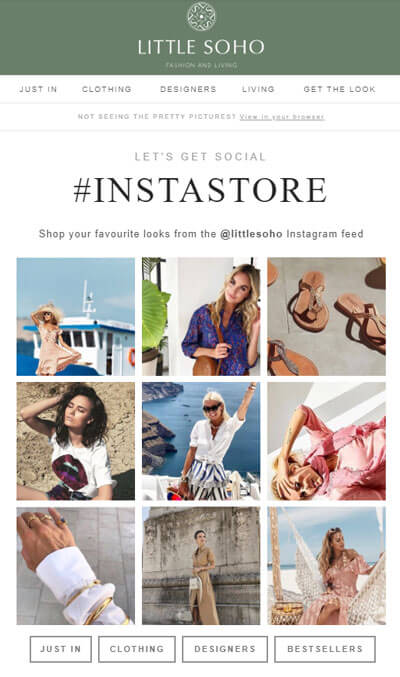
So don’t save all your UGC juice just for social media. Share the love with your email marketing campaigns! Since UGC has the potential to plug up the holes in your marketing strategies when it comes to conversions and click-throughs, you should integrate it wherever you can.
Consider some of the most common challenges of email marketers in 2017 according to Campaign Monitor:
User Generated Content can help with easing all of these pain points. And you don’t have to scratch your current email marketing campaign to do it. With a little bit of tweaking and some creativity, you can concoct the best email marketing strategy using UGC for your brand.
In fact, you should be using UGC in your emails to encourage users to create more content for you. With an email based hashtag campaign, you’re sure to get more people snapping shots in your products.
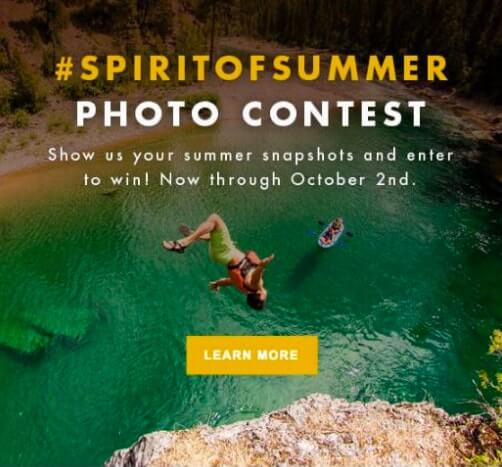
Plus, your social followers are a resource for the rest of your marketing strategies. Think of you Instagram followers as potential email subscribers – so they never miss a beat of your content.
According to a recent Litmus’ 2019 State of email survey, for every $1 that your brands spends on email marketing you can expect £42 return, which is a 31% increase from 2017. Now add that to User Generated Content conversion power, and you’ve got your reason for integrating UGC into your email marketing strategy.
The key takeaway here? Email and social media shouldn’t be totally separated. This is especially true as experimenting with UGC through email is so simple.
Whether your goal is more sales via email or leading customers to your shoppable social feed, UGC and email combined are a powerful combination.
Another crucial way to use UGC is in Facebook Ads.
Facebook users, AKA most people, spend their time scrolling through an endless cycle of news, pictures, and ads. They get pretty good at spotting an ad and immediately scrolling past it.
But with UGC, you’re more likely to get users interested in the content that you’re sharing because it’s more natural and real – just like the pictures that they expect to see of friends and family on Facebook.
Plus, it cuts your Customer Acquisition cost! Which we’ll go into further in the cutting CAC section of this article.
Facebook ads with UGC result in a 300% higher click-through rate, a 50% lower cost per click, and a 50% lower cost per acquisition.
Facebook ads with UGC result in a 300% higher click-through rate
Flowbox makes it easy to get your customer content integrated into ads. With our Media Rights Tool, you can easily request all rights to photos and videos, ensuring that you can use this content wherever you like.
There’s no limit to the potential of your UGC. If you love a customer picture so much, once you have media rights, you can even stamp it on a billboard and make it the face of your latest campaign.
As Beyonce says: If you’ve got it, flaunt it. Show off your UGC everywhere you can, and start experiencing the benefits.
Looking for more? We have 2 data-packed resources for helping you stretch your UGC as far as it will go:
Facebook Ads Case Study with Kids Brand Store
User Generated Content moderation is crucial. It’s exciting to see users posting for your brand on their social channels – but it can get overwhelming when your hashtag is full of content for you to choose from. Especially when there’s some content that you don’t plan on using in your marketing efforts.
That’s why User Generated Content moderation is one of the most important steps of any UGC marketing strategy. It helps you keep your brand’s look and feel intact while you use your target audience to generate brand awareness for you.
An effective way to ensure that you’re only collecting content that you want to use is with tools like Blocked Users and Whitelisted Users. These are 2 Flowbox tools that allow your brand to block spam content, while giving a green light to content that you know you’ll be interested in seeing.

From there, managing your content is easy, as you just need to approve the images and videos that you’d like to appear on your eCommerce – and maybe even connect them with a product to make your customer content shoppable.
Like User Generated Content moderation, requesting User Generated Content permission is an important step in the lifecycle of your user content. Our rights management suite allows you to send content permissions with ease.
Looking for more? To learn all of the ways that you can more productively moderate your content, check out our helpful resources below:
How Flowbox collects your User Generated Content
How you can manage your content with Flowbox
Feel like you spend way too much money trying to bring in new customers? You’re not alone – eCommerce customer acquisition cost can get pretty crazy if you aren’t going out of your way to keep that cost low. In fact, it’s approximately sixteen times more expensive to bring a new digital customer to the same level of profitability as a past one.
It’s approximately 16X more expensive to bring a new digital customer to the same level of profitability as a past one
And one of the best ways to keep customer acquisition cost low is to use customer content throughout your marketing efforts.
If you’re a bit skeptical about using customer content in your social media ads, consider this: Facebook ads with customer content result in a higher click-through rate and a 31% lower cost per click.
In other words, you’ll get a much better return on your advertising investment if you incorporate some kind of customer content in your Facebook ads. And you’ll see similar results on Instagram, where ads featuring customer content convert better than traditional, professionally styled ads.
When someone visits your site to purchase one of your items, they’ll have pre-sales questions they need answered before they can confidently make a purchase. For example, if you sell women’s dresses, these are some of the pre-sales questions your customers might ask themselves before buying a dress:
If you can answer these kinds of questions for people who visit your site, there’s a good chance you’ll be able to convert them to paying customers without having to hire more customer service employees or software.
The best way to do that? User Generated Content. More specifically, photos and reviews.
Besides, nearly 90% of buyers put more stock into user reviews than anything else you could possibly say.
Take a look at this dress for sale on the Modcloth website:
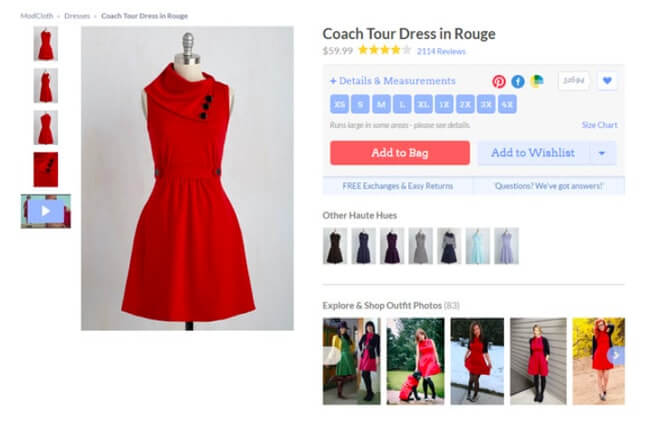
You can see that it has over 2,000 reviews – and most of them are positive. On top of that, there are 83 outfit photos from actual customers. Not only do those earned content elements answer pre-sales questions like the ones I mentioned above – they also build trust and help potential customers overcome objections that might cause them to not buy the product.
Dig a little deeper into the reviews of this dress, and you can see that there’s a lot more information there about it:
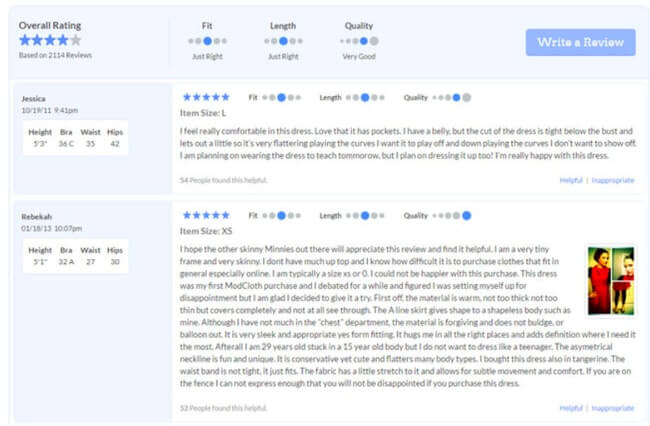
As you can imagine, showing the customer this much customer content to support the quality of your product is pretty effective at increasing conversion rates on your eCommerce website. I’m not just saying that – research shows that customer reviews result in a 74% increase in product conversion. And one Urban Outfitters study showed that adding a UGC Flow of customer photos led to a 15% shopping rate improvement.
An Urban Outfitters study showed that adding a UGC Flow of customer photos led to a 15% shopping rate improvement
Reviews aside, there are also tons of other formats that you can play with, including carousels and galleries, lookbooks, and more. You can even show customer photos alongside your regular product photos in product pages.
These are all great for conversions as well, with one CLUSE watches study showing that adding a customer content gallery of customer photos led to a 19% shopping rate improvement. Those kinds of results translate directly to lower customer acquisition costs.
Building a loyal, hungry base of customers is the ultimate goal of any business; however, customer retention is a massive area of concern for mainstays and budding brands alike. The concept of creating lifelong customers can be absolutely daunting. After all, new brands are popping up daily: meanwhile, trends change, and even the most promising fits can quickly become flavors of the week.
So, how do you make long-term customer retention a reality in the incredibly competitive and crowded eCommerce landscape?
Look at it this way: customer content represents social proof as customers actually see your products on display from real people in real-time. Encouraging the creation of User Generated Content is perfect for customer retention.
After any purchase, you immediately provide your customers with an action to take to continue to interact with your brand. The more interactions, the better as you work to cement a stronger emotional connection between your brand and buyers.
Looking for more? Here’s a cool resource to help you further understand how UGC can cut your customer acquisition costs:
Customer Acquistion Cost: How to lower eCommerce CAC with UGC
We’ve just addressed how you can use User Generated Content to combat your customers’ pre-sale questions, leading to increase purchases. But another snazzy benefit of loading your customers up with as much information as possible via customer content is that you can reduce your return rates by doing so.
Did you know that $62.4 billion worth of apparel and footwear alone were returned in 2016 due to incorrect fit?
$62.4 billion worth of apparel and footwear alone were returned in 2016
To understand how this happens, first, let’s have a think about why people return products.
Why do people return products on eCommerce stores?
There are many reasons, but the most common are:
That last one is the most common reason for eCommerce returns. The item didn’t fit.
Going back to that $62.4 billion figure – that amounts to over 23% of all returns! But what if I told you that visual customer content could help solve some of these common return issues? Let’s start with item fit.
Because 70% of customers check reviews or ratings before making their final purchase, providing customer content is a great way of empowering your customers to choose items that fit them best. Let me give you a personal example.
70% of customers check reviews or rating before making a final purchase
I’ve been looking for new sneakers that are comfortable enough to wear on the street but nice enough to dress up with a skirt or dress. I’d heard of Greats as a cool, upscale sneaker brand, so I checked out their website.
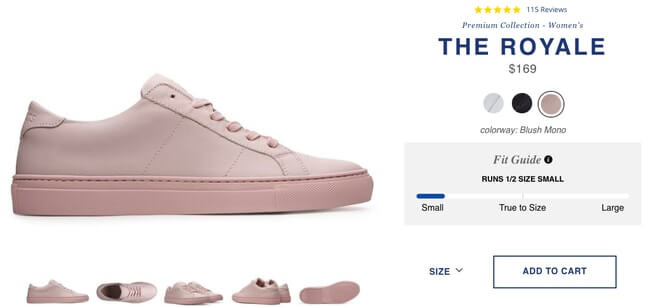
There, I found an amazing pair of blush sneakers, but I wasn’t sure how they would fit. Luckily, Greats has a Fit Guide integrated directly next to each pair.
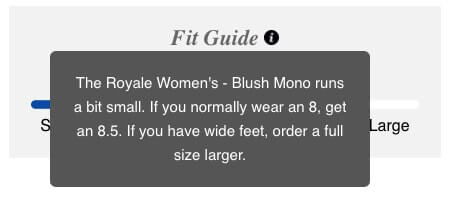
But I still have doubts, how can I really know that these are going to fit? My eyes find the customer reviews shown directly at the bottom of the page. One review actually verifies that, yes, the Fit Guide is correct – go up a size!

It’s so great to see that your purchasing fears are not something to fear at all. Plus, other customers are using the shoes exactly how I plan to – “comfortable yet classy”.

And any last doubts that kept me from committing quickly dissipated when I noticed the UGC product gallery, showing fun pictures of real people wearing the shoes that I’m on the verge of buying. Nothing says you’re making the right choice like seeing how cool and desirable the product is in the eyes of other customers.

As you can see, I’m a part of that 70% who prioritizes reviews when purchasing products. This is because user reviews are typically unbiased, accurate and paint a better picture of the quality of a product based on real use.
By ensuring you have sufficient customer content on your site, you’ll be giving your customers the information they need to buy the right product, in the right size!
Now, let’s think about how UGC can help alleviate returns based on customer expectations.
When Redken not only shares the post of an adoring follower but includes their review of the product directly onto the UGC post, followers can trust that the information they are getting is accurate and not specifically designed by the brand to get you to buy their hair products.
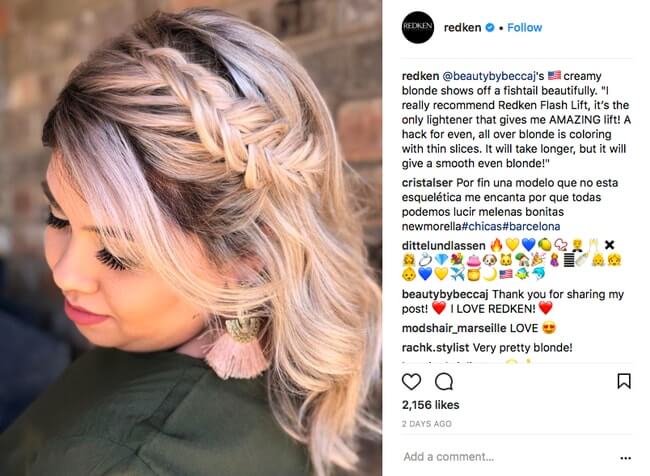
Here, it’s not Redken telling you why their product works, it’s Becca J. And, since Becca J. isn’t a member of the marketing team, she has no reason to tell your customers anything but the truth – that the Redken Flash Lift actually gives her an AMAZING lift!
Now customers know exactly the effect they can look for from the product, meaning more expectations being met from the start.
Plus, it’s always helpful to get a nice shout-out from the original poster herself. Note Becca’s comment “I LOVE REDKEN” directly on the post – now that’s UGC magic in action.
There are so many different scenarios where UGC can help reduce return rates. Imagine buying a dress for a wedding and opening the box to see that the product description wasn’t quite as thorough as it could have been. Instead of purchasing a different dress from your store that was more appropriate for the occasion, your unsatisfied customer is now returning the dress upon opening the box.
One piece of User Generated Content could have helped that customer understand the way the dress would look and feel before they moved ahead with purchasing. Meaning that UGC helps consumers choose the correct product the first time around.
Not only that, but it can be a learning experience for your brand. If you see a customer photo or review explaining that something wasn’t quite as expected from the product description, you can go in and change that on your eCommerce site to help future customers.
The more voice you give your customers, the better your eCommerce store will perform all around.
Looking for more? Check out this in-depth article on how to reduce eCommerce returns with User Generated Content.
In a marketing world that trusts UGC 92% more than advertising, firsthand photos are always a safe bet. So now that you’ve learned all there is to know about User Generated Content marketing, it’s time to actually do it! Read on as we walk you through how to collect User Generated Content with the right platform.
So you understand its value so the next step is to determine how to collect User Generated Content. Read our tips for how to collect User Generated Content below:
But do you really want to spend your days plunging through the depths of Instagram to find photos? Not to mention that you would have to figure out how to present the content on your website in a way that’s stylish and engages customers instead of turning them away.
We suggest you make the most out of your UGC strategy by utilizing a User Generated Content platform.
Want to learn how to collect User Generated Content with ease? Book a demo of the Flowbox platform.
With a User Generated Content platform, or social media aggregator as some people call it, the process of collecting, publishing, and analyzing your customer content is seamless. For a better understanding of what I mean, let’s lay out the ways in which a User Generated Content platform can benefit your eCommerce efforts and online shopping journey while talking about how to use current technology to get the most out of your UGC strategy.
When you connect your social media efforts with your eCommerce store, you’re building the social proof that customers need at the point of purchase. We’ve already seen some examples of how brands publish UGC into their eCommerce storefronts, as well as connecting their products directly to customer photos and videos. Once you’ve got this down, you are ready to start analyzing this content! User Generated Content platforms give you the control to ensure you’re always putting your best foot forward. This means choosing the strongest UGC – then making sure that everyone sees it.
Working with a User Generated Content platform directly. This tool analyzes which photos have been resonating with your customers providing key metrics like conversions, impressions, and click-through-rate (CTR) to give you complete freedom to filter as you please! The platform even lets you see exactly how well each of your widgets is performing – down to the actual revenue driven per content piece.
How do you know what your strongest UGC is? The ‘Posts’ tab in Flowbox Analytics is designed specifically for that.
The Posts section in Analytics offers valuable insights into the performance of individual content pieces amongst your clientele. By monitoring various core metrics brands can develop a comprehensive understanding of the content that resonates most with their audience. This information aids in identifying high-performing content, empowering brands to replicate its success in upcoming campaigns.
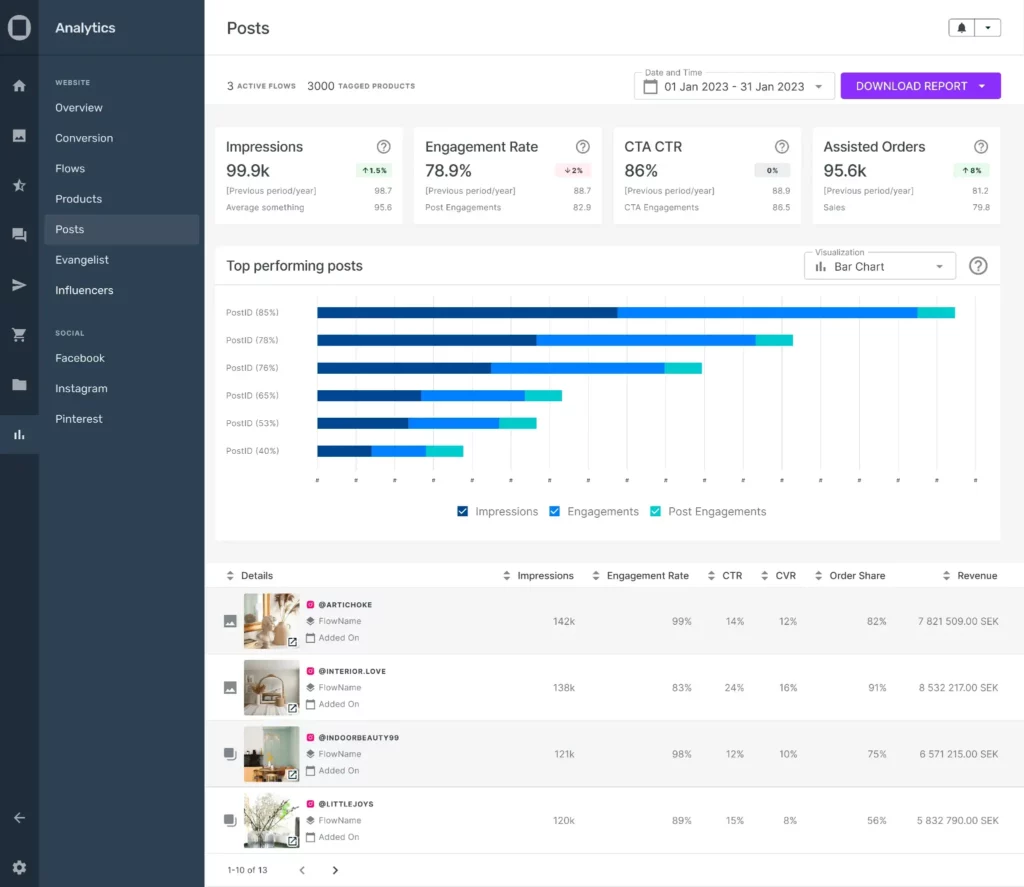
When it comes to collecting, publishing, and analyzing your customer content, and refining your strategy, a User Generated Content platform is really the way to go. Photo and video integration is seamless, and it will do wonders for your eCommerce storefront. If you’re not using a User Generated Content platform or aren’t happy with the one you have now, request a demo today and experience it for yourself.
Looking for more? Look at this helpful resource on getting the most out of your UGC strategy with what to look for in a high-quality UGC integration.
There you have it. That’s everything you need to know about User Generated Content. We hope you found this guide useful! If you still have questions, we want to hear them – let us know in the comments below.